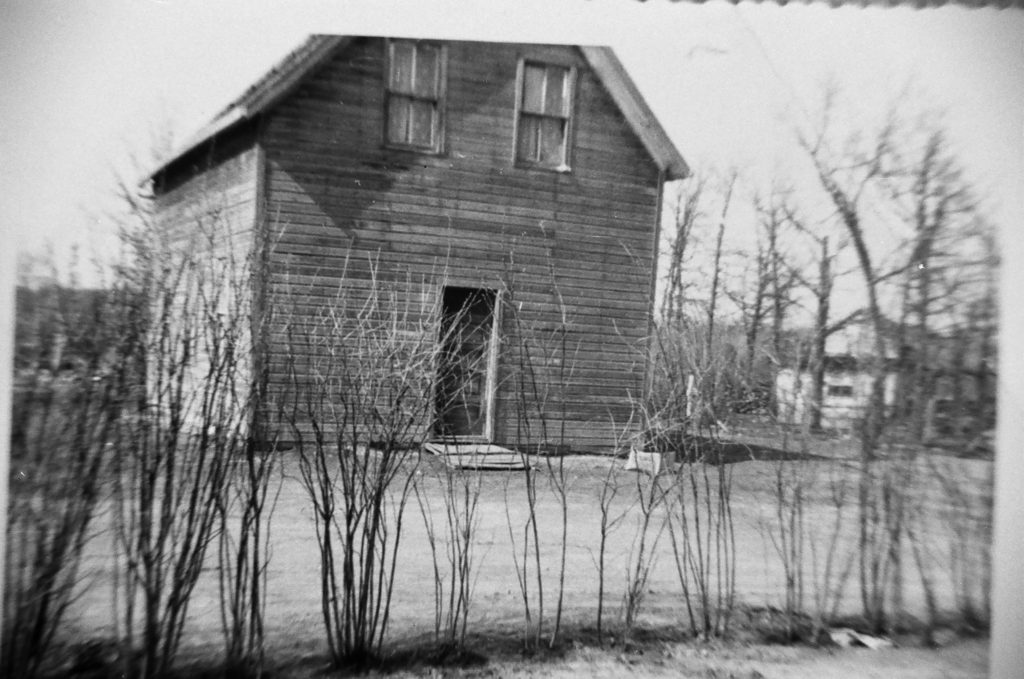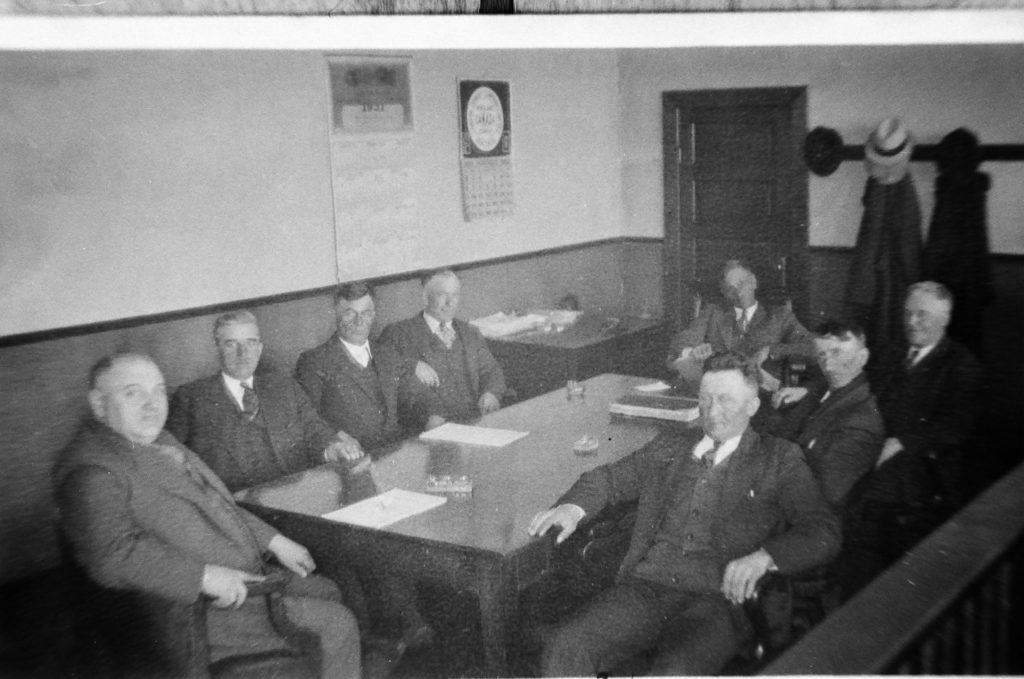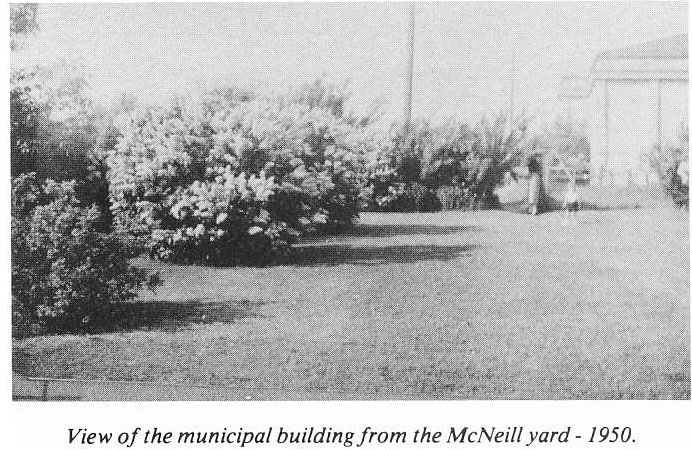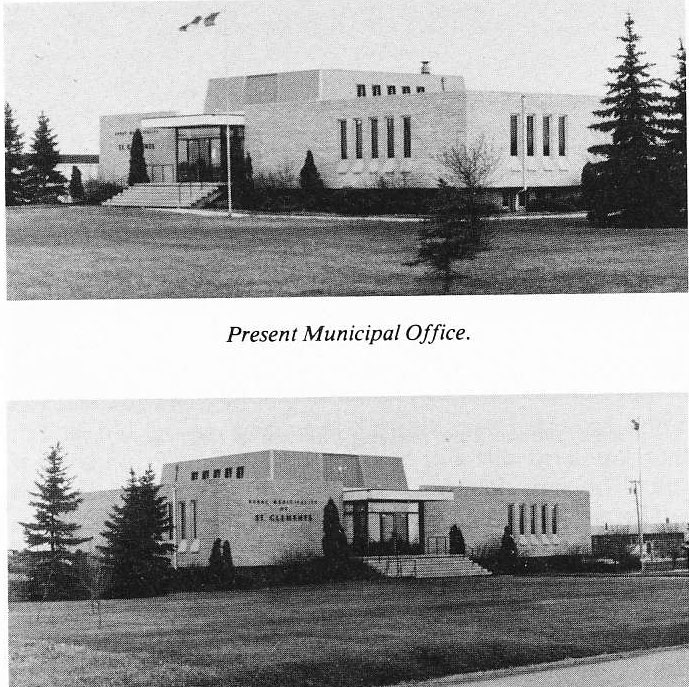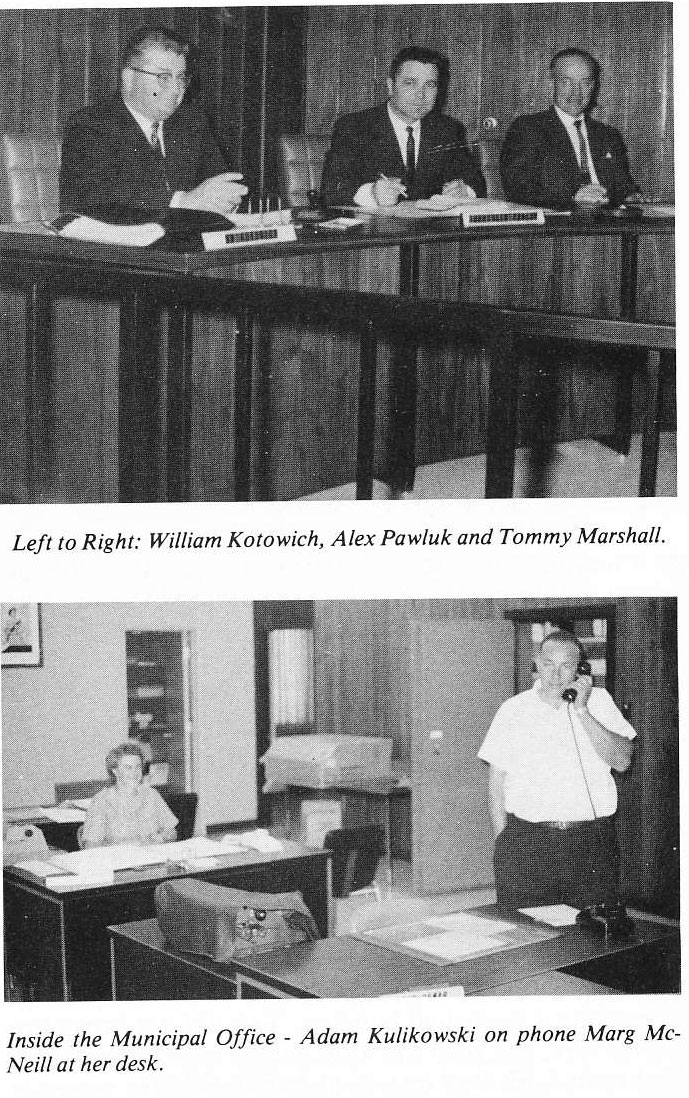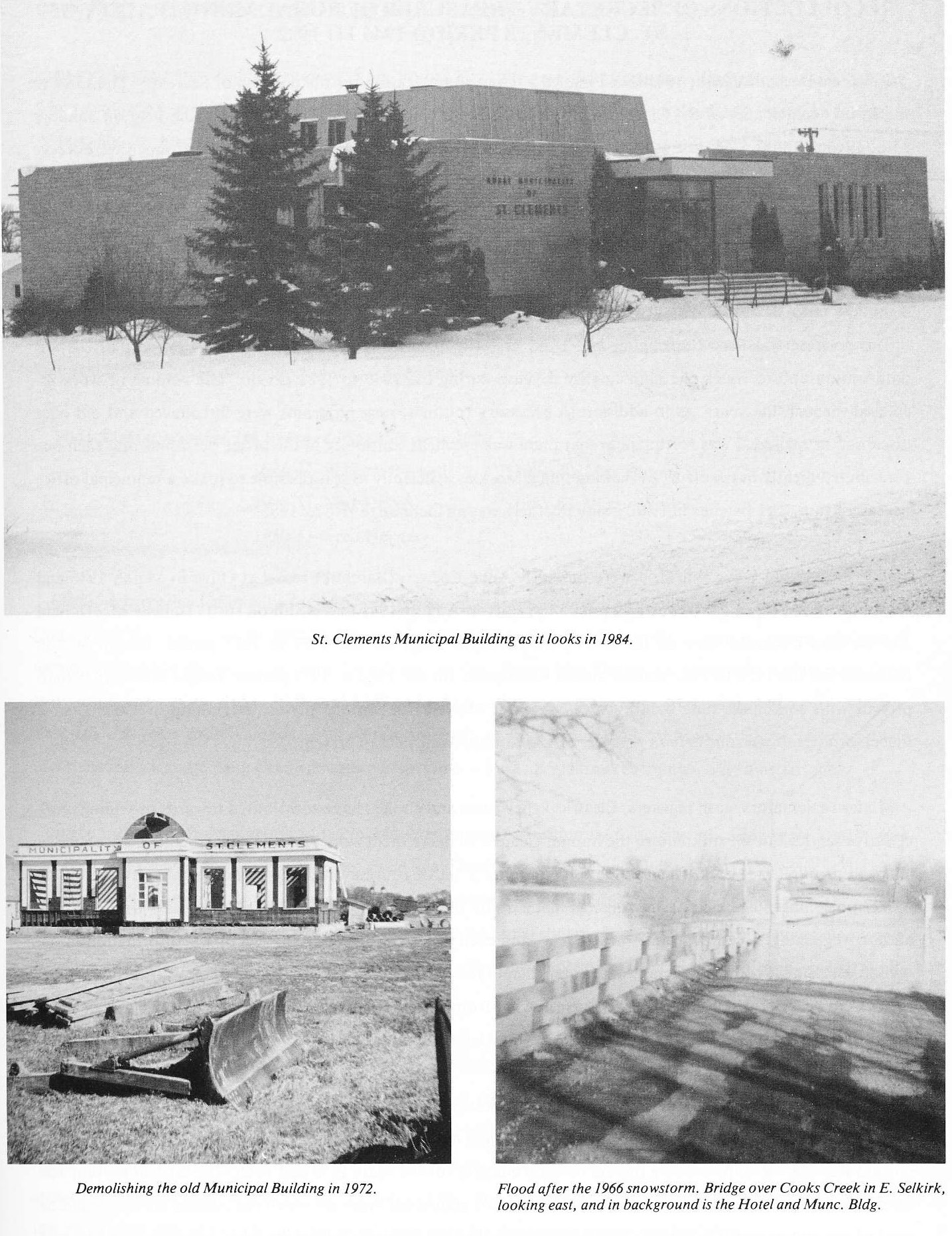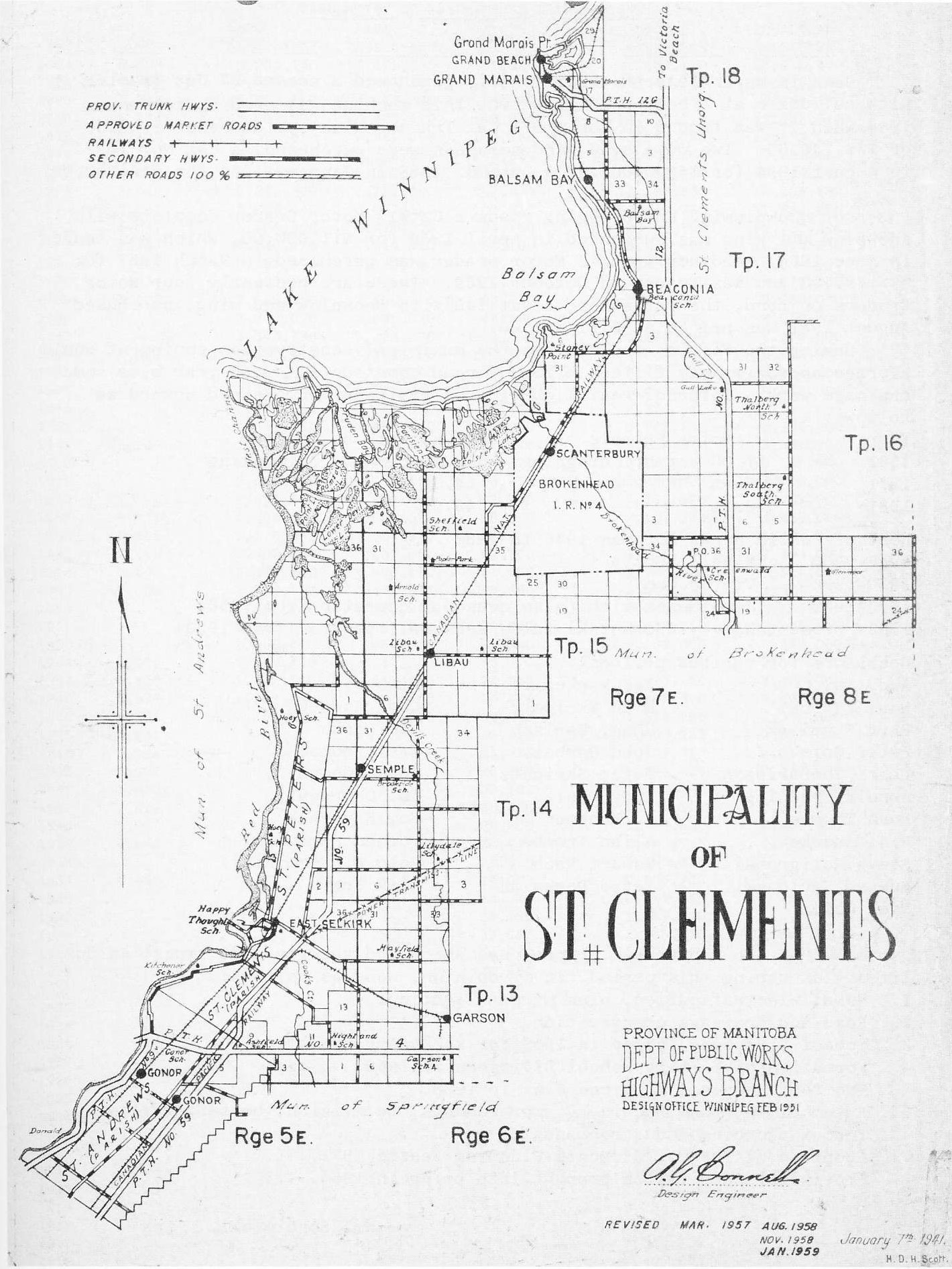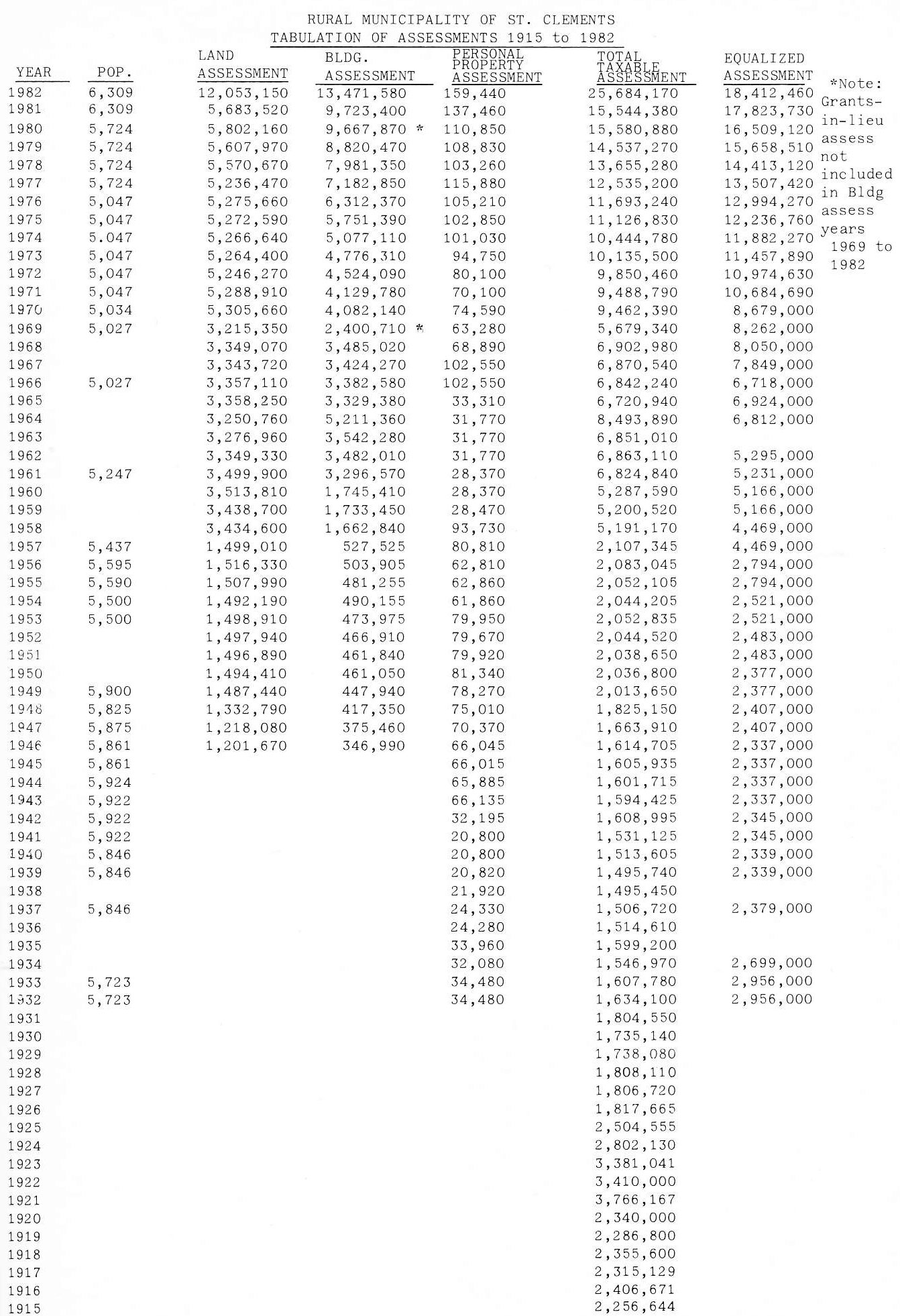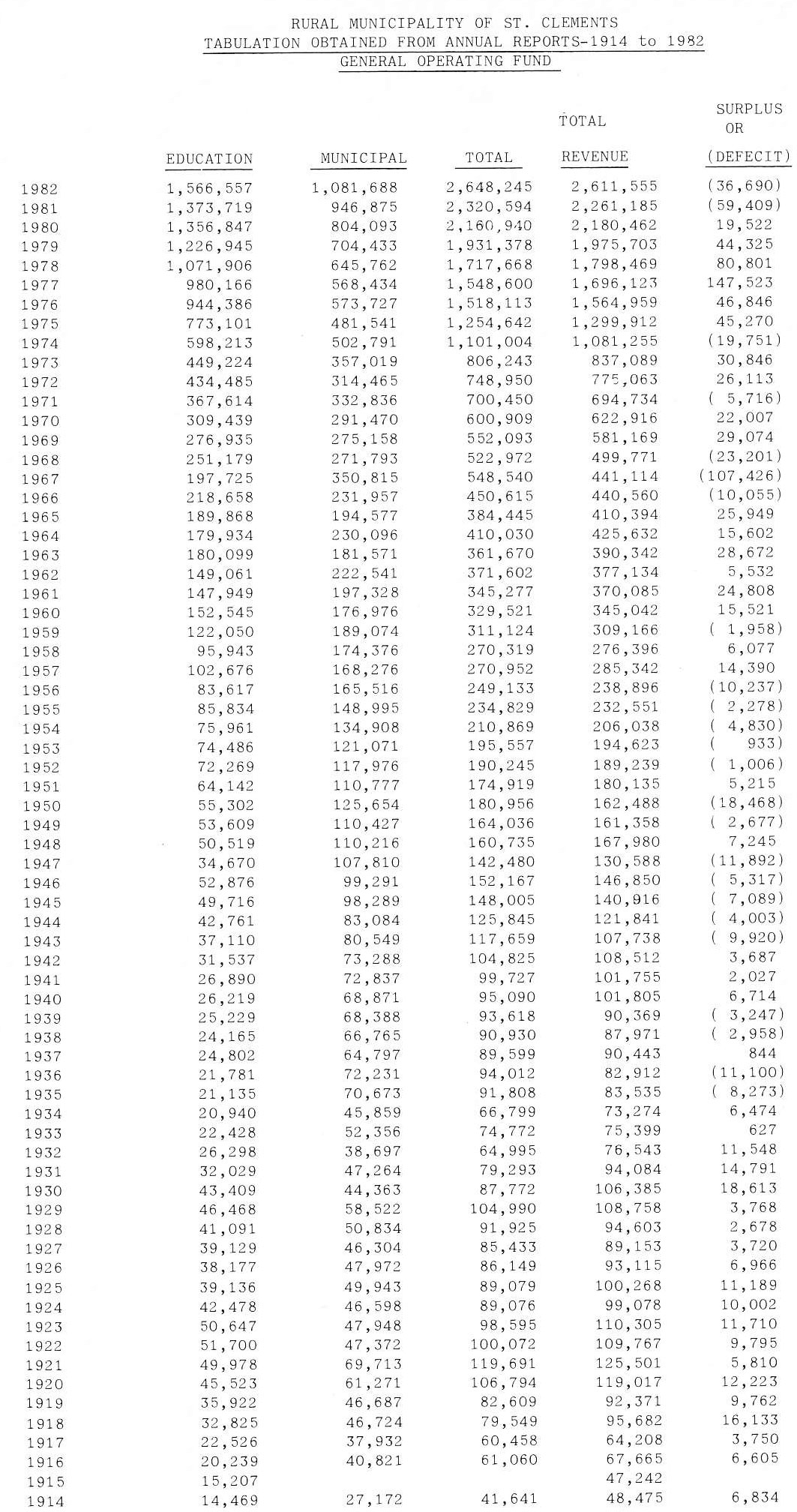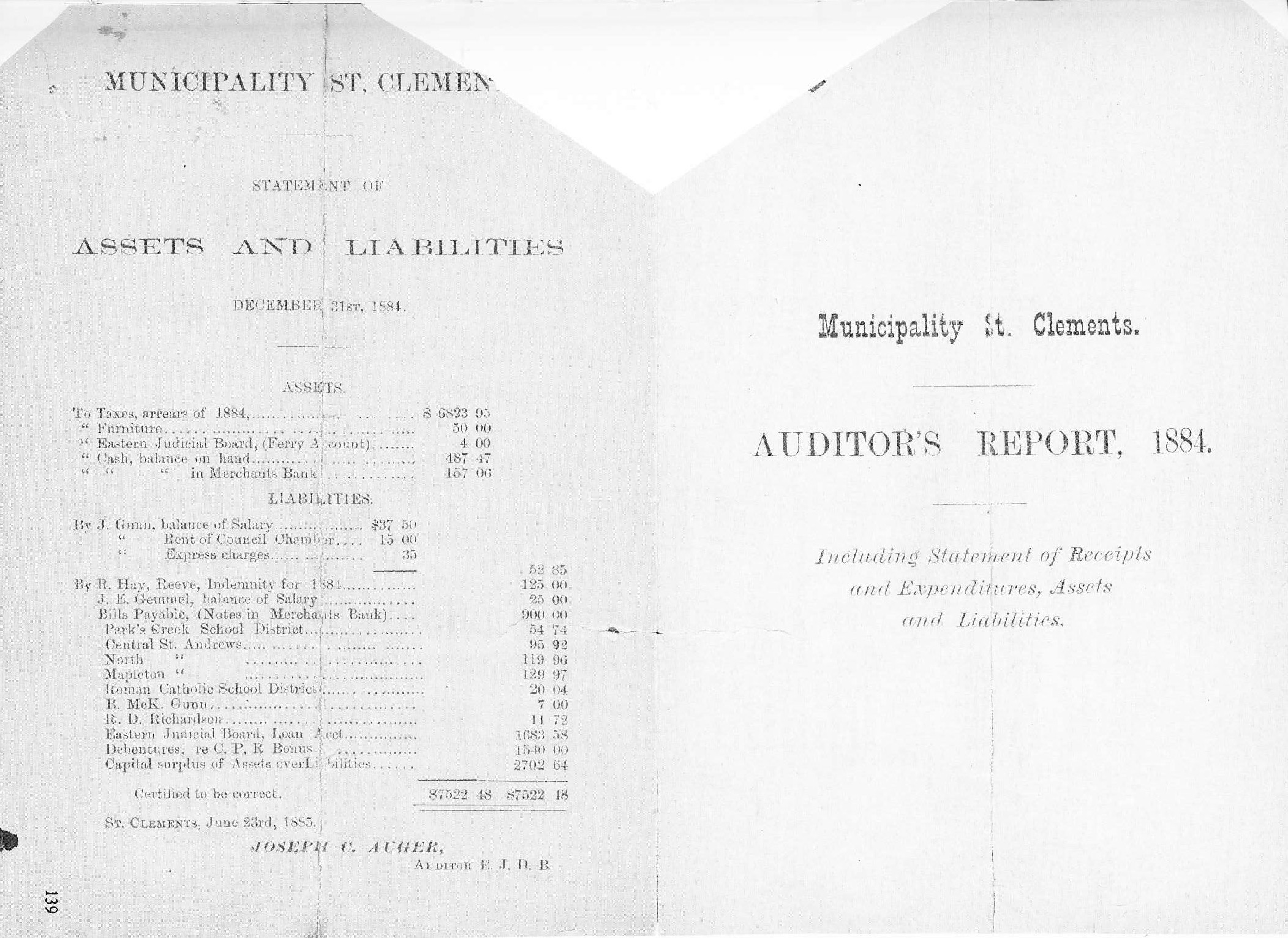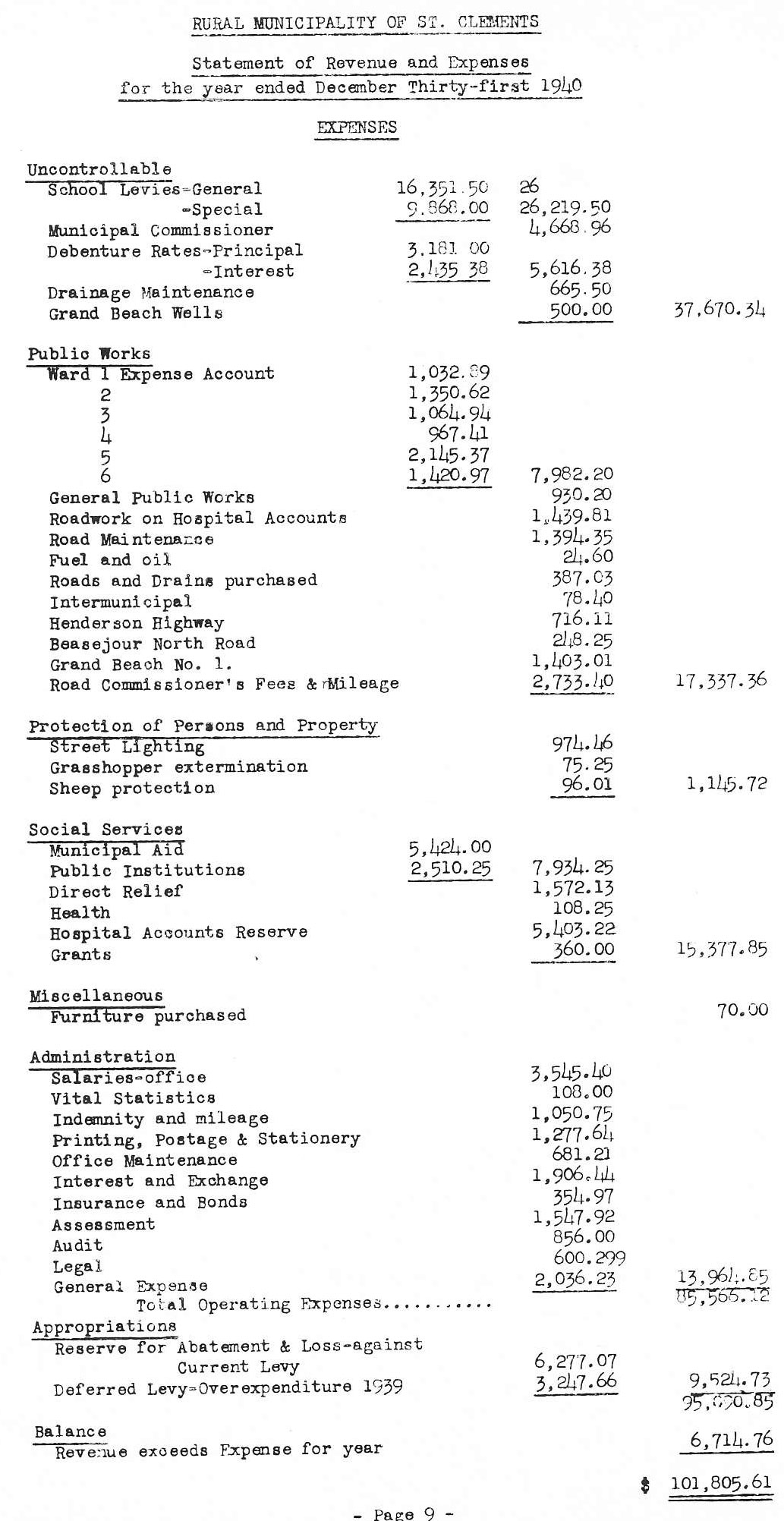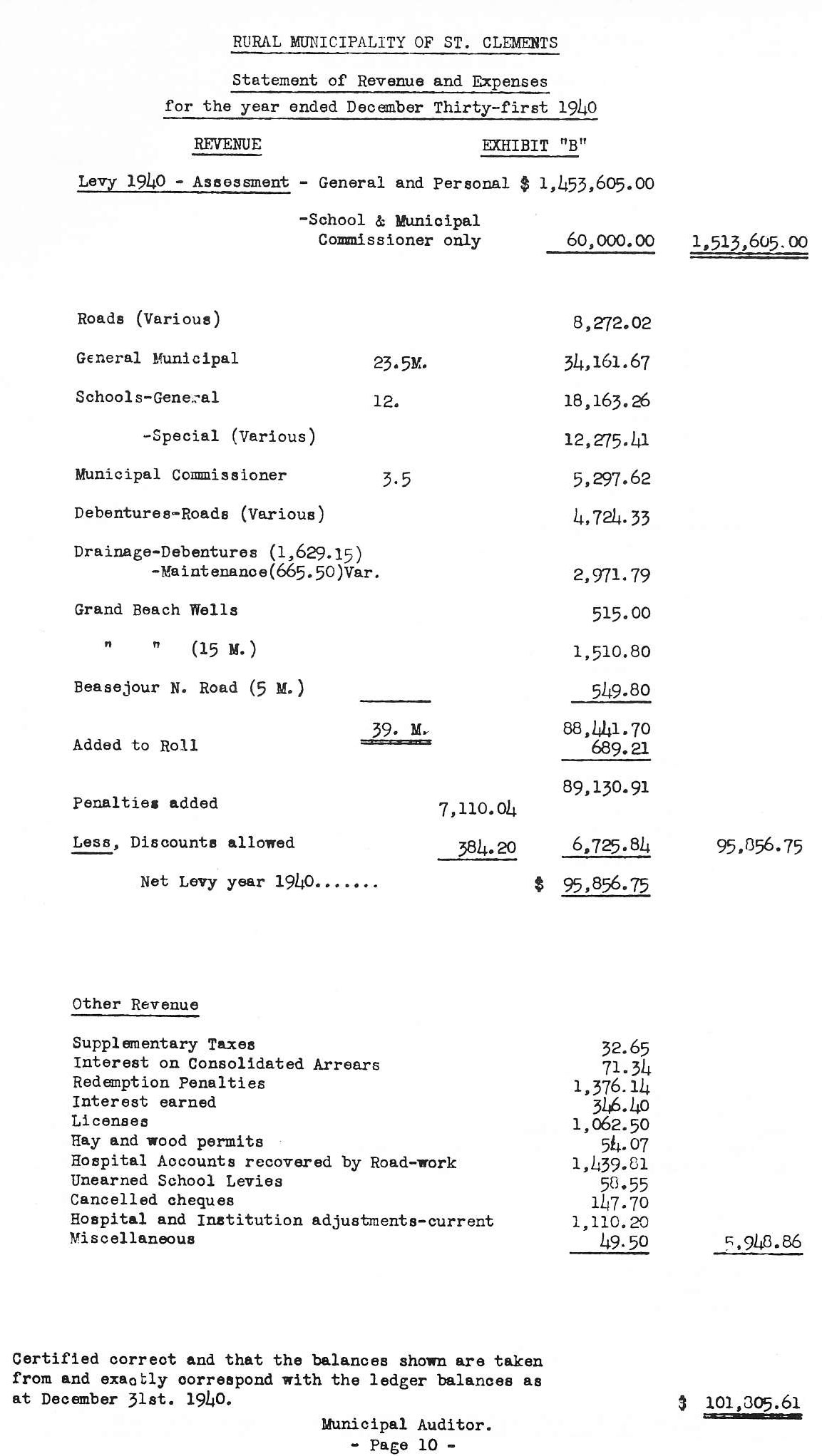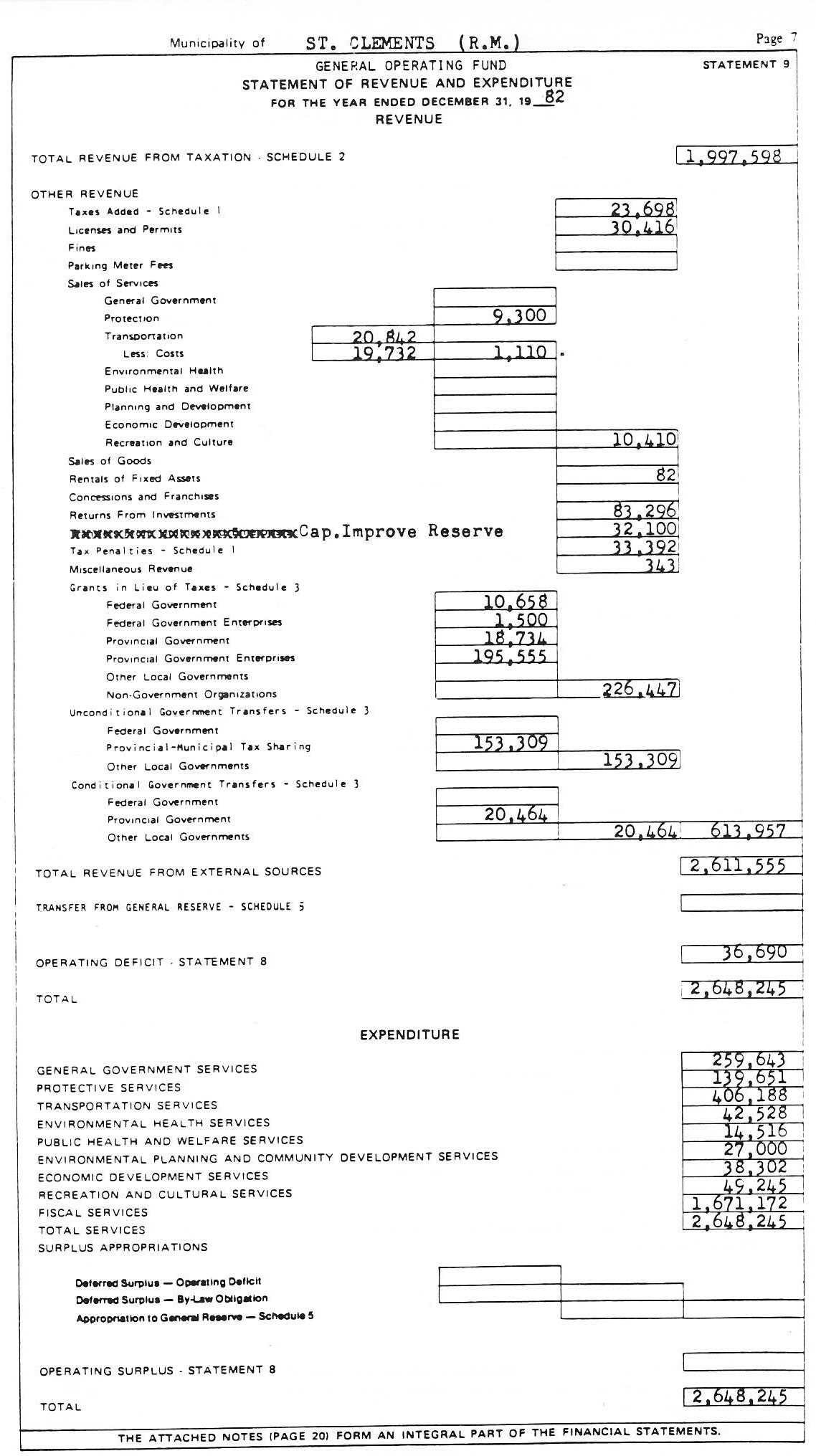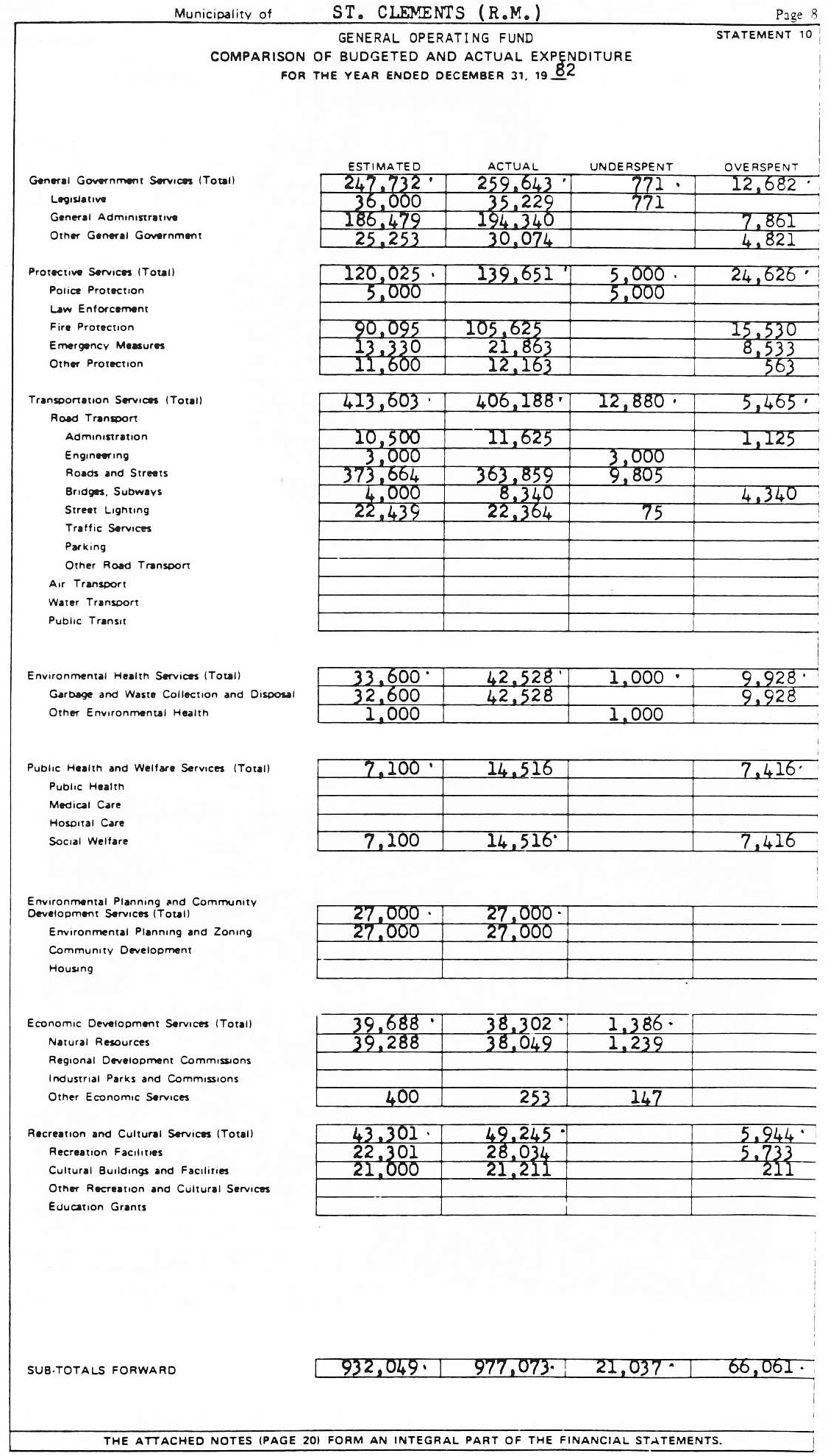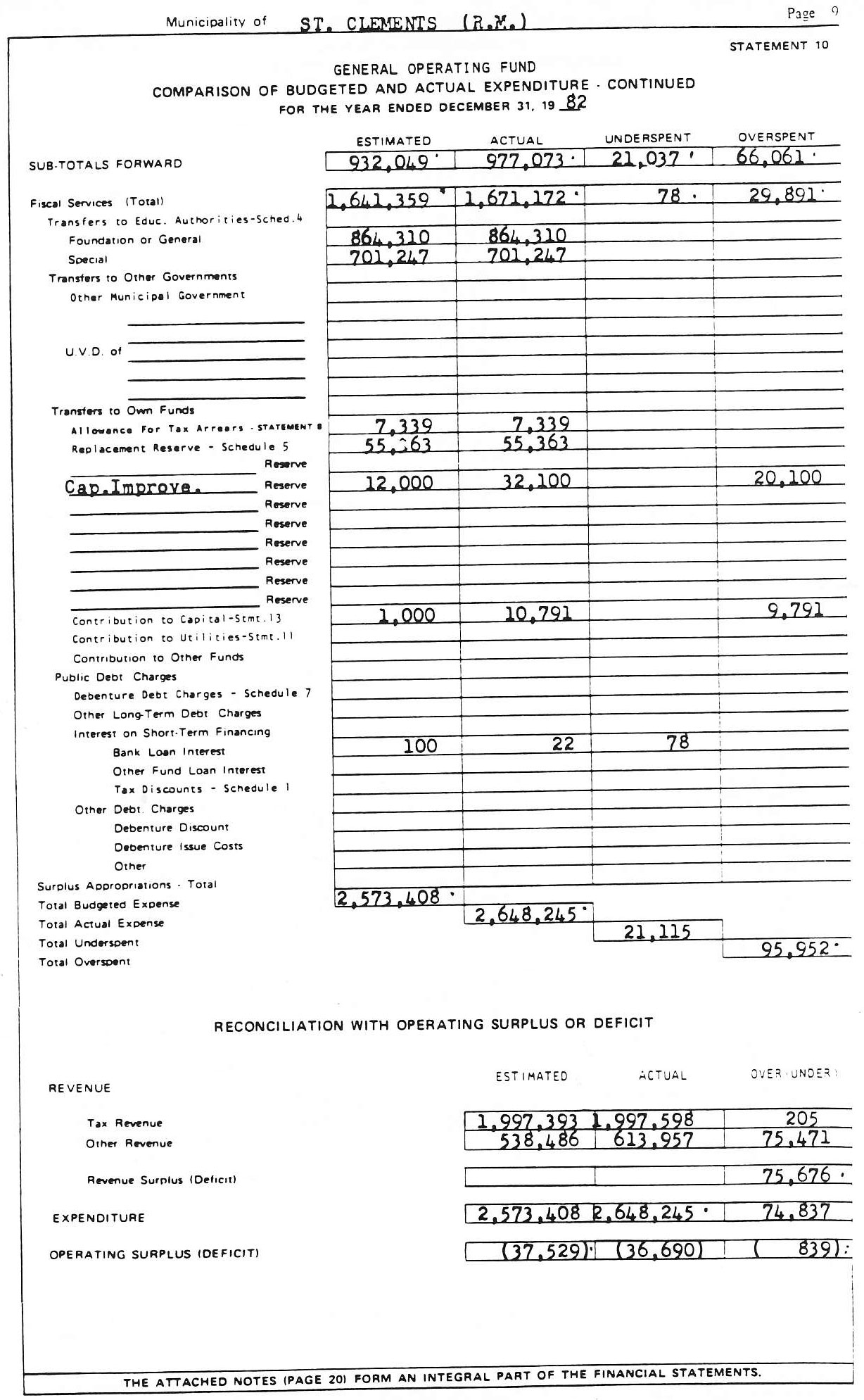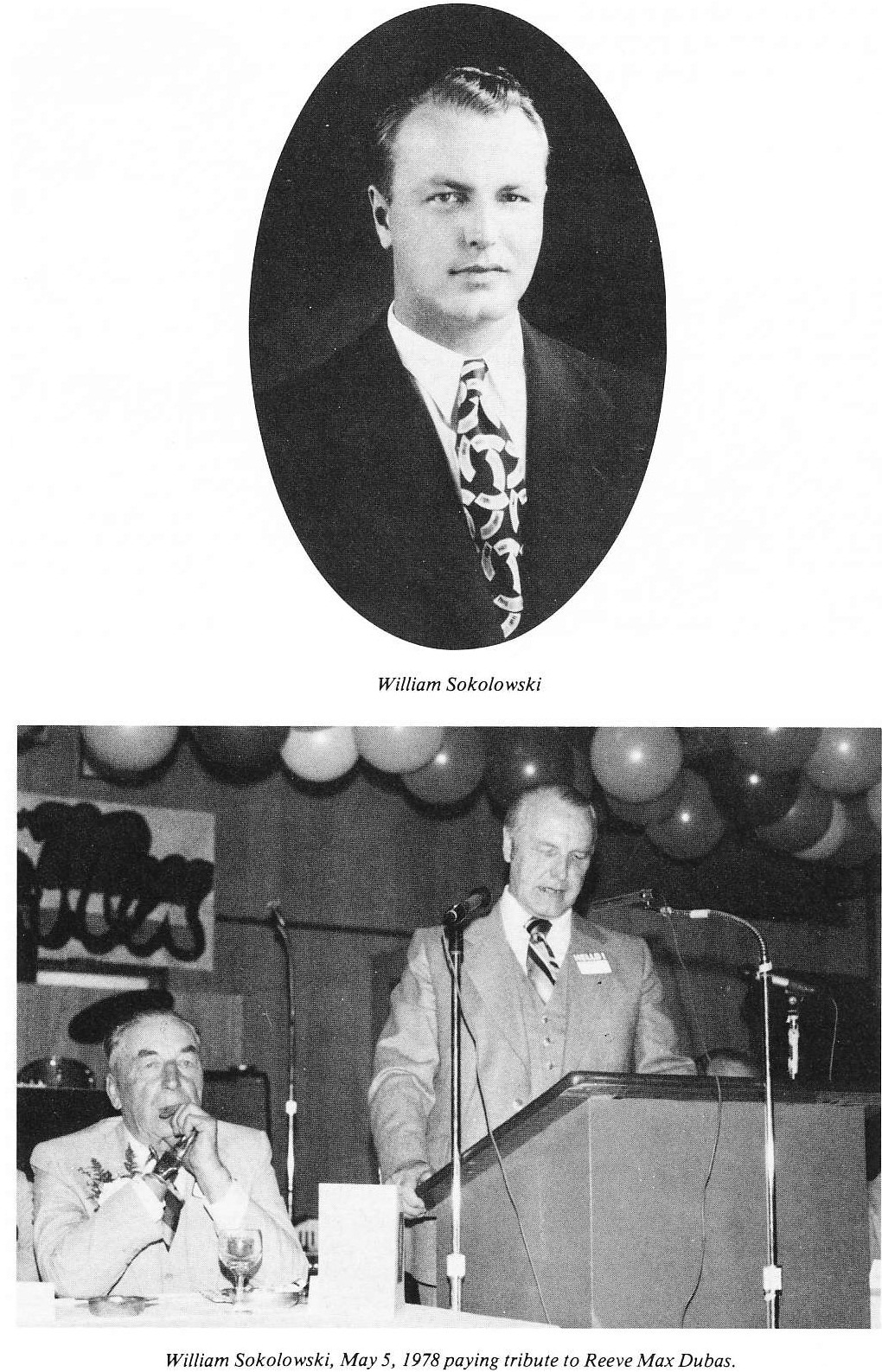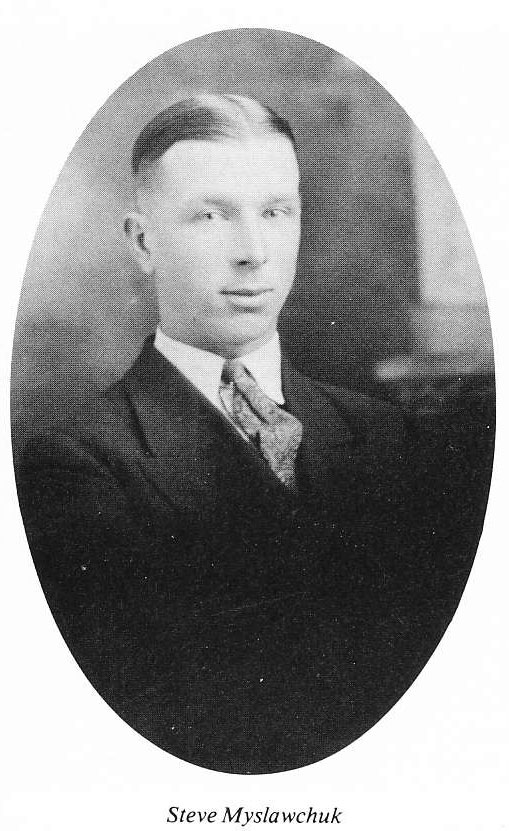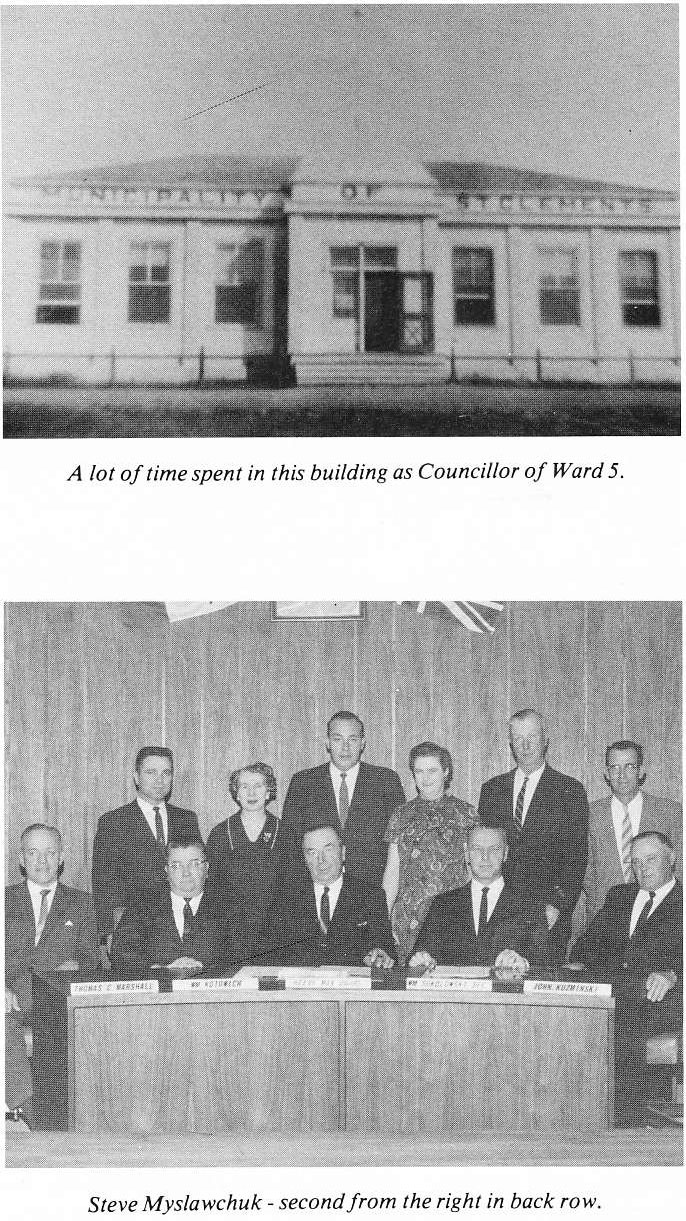The first Council Chamber, to the best of my knowledge, was located on the old Main Road (now known as Henderson Highway) on part of Lot 94. It was the old McKay residence. A photo has been located after much searching and we include it here as a record of our humble beginnings.
The old home was used for all meetings and some socializing. Mr. Wlm. T. Fiddler did the brushing and banked up, as well as, made a firebreak around it annually. He also hauled wood for winter heating of the building. It would appear he was paid about $6.50 for all this work. Mr. W.R. Swain was the Caretaker, off and on, and he was paid $2.00 per month for his effort. Annabelle Fiddler did the cleaning chores of scrubbing and dusting. She was paid $2.25 for this duty.
The insurance for the first council building was with the City of London Assurance Company and the premium on the Chamber was $ 16.50 for three years.
ln the year 1895, Claude R. Macfie supplied 6 cords of green Poplar wood, delivered right to the site for the sum of $6.00 total.
The Council Chamber received a thorough face-lift in the spring of 1900 when Wlm. T. Fiddler repaired and painted same, receiving $15.75 for his contract. That fall he put in new windows and a gate for the chamber.
The Kitchener S.D. used the building for school purposes from Sept. 1900 until their new school was built during the summer of 1901.
William Fiddler was always repairing the building, it would appear, from the accounts listed for payment. Anything from broken windows to splintered guardrails.
Early in 1907, Council authorized the building of a shed, about 24′ x 16′, made of shiplap, having two doors and being shingled, to be on lot 94. By Oct. someone had locked the safe and no one could open it, and Council paid $20.00 to have it opened and then repaired. During the year 1909, the Town of Selkirk approached St. Clements several times to move to the Town of Selkirk and rent premises there for holding their meetings. Council, after some discussion turned the offer down.
From March of 1910 to March 1912, Council authorized the purchase of a typewriter, new tables, chairs and a desk.
Also, it is to be noted that Council was purchasing large amounts of lumber from Hooker’s Lumber Company in l9l1/12 and storing it at the yard for municipal work.
It was Councilor J.B. Burnett who gave notice in March of l9l3 that he was going to introduce a by Law to acquire a parcel of land upon which to erect municipal buildings. He did so on May 6, 1913. Resolution No 109 authorized the Reeve and Secretary-Treasurer to purchase Lot 41, East Selkirk, from David Morrison, for the sum of $300.00. By Law No. 76 was read 3 times and passed for approval, allowing land purchase as well as erecting and maintaining a hall and other municipal buildings on same.
Earthy in 1914, Mayor Ross of Selkirk had offered St. Clements accommodation to hold their Council meetings in the Selkirk Town Hall until such time as the proposed new Hall at East Selkirk was built and ready for reception.
An “adding machine” was bought in May, 1914, at a cost of under $50.00.
During that summer (1914) Council only met in the Selkirk Town Hall once and returned home again. They spent the summer on Lot 94 on the east side, and transferred
their necessary books and furniture to new quarters within the Town of Selkirk in Nov. 1914.
So, from Nov. 1914 to Aug. 1919, the Municipality of St. Clements rented space in the Dominion Bank Building within the Town of Selkirk for the purpose of conducting business. The rental was $20.00 per month. The rent never increased during the 5 year period.
In 1916, the old Council building was advertised for sale (Lot 94) including lot and all buildings. It had a shed and stable on it. Mr. Claude R. Macfie offered $250.00 for it and Council accepted his offer.
The authorization to build a new Council building was given in the spring of 1919 and G. Bjornson was the contractor. The location was to be further north in the Village of East Selkirk. There was some opposition and petition against the location, some ratepayers wanted it further north and some more south. You will recall that Council, in 1913, had purchased Lot 4l for the purpose of erecting a municipal building. This did not prove too satisfactory, so Council in 1919 had arranged to purchase land from J. McNeill on Lot 20, in East Selkirk.
The progress payments to Bjornson, the Contractor, was $1,500 when roof was completed, $1,500 when plastering done and the balance when the building was finished. E.P. Hicks inspected the building. $3000 insurance was placed on it in June 1919, and the furniture was moved over from the Dominion Bank Building in Selkirk by Aug. of 1919. Council held its first meeting in their new East Selkirk quarters by Sept. 9, 1919 with all members present.
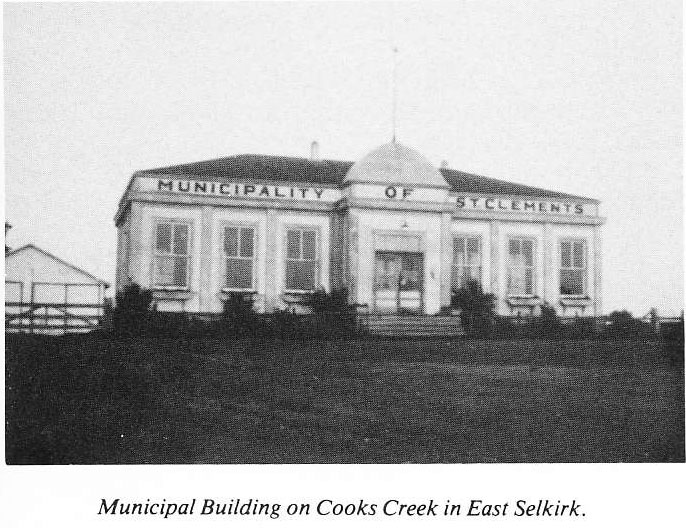 Mr. McNeill became the first Caretaker of the new structure and by Feb. of 1920 the “Grain Growers Association” of East Selkirk were holding their meetings there as well as other organizations on occasion. Municipal business was conducted from 9 a.m. to 5 p.m., Monday to Friday and from 9 a.m. to 1p.m. on Saturdays.
Mr. McNeill became the first Caretaker of the new structure and by Feb. of 1920 the “Grain Growers Association” of East Selkirk were holding their meetings there as well as other organizations on occasion. Municipal business was conducted from 9 a.m. to 5 p.m., Monday to Friday and from 9 a.m. to 1p.m. on Saturdays.
The actual bylaw to allow the purchase of land for a new Council Chamber (hall) and “other municipal buildings” required by the municipality was not introduced until June 15, 1921. lt was numbered No. 206.
They used coal for heating this building and Mr. Halabowicz painted the “Council Chamber Sign” at the same time as he was contracted to paint the speed signs for the roads. He was paid $230.00 for total contract.
Bylaw No. 217 (Feb. 1922) was the final record of sale for Lot 94 to Claude R. Macfie for the old Council Chamber.
ln June of 1922 a “railing” was built to divide the Council Table from the guests.
As a matter of interest, Council was continually purchasing new chairs for the Chambers as it was the custom at the time to present a retiring Councilor or Reeve with their chair as a token of appreciation for service.
The building was kalsomined annually and kept in repair regularly.
The “printing machine” (Gestetner) was purchased in Sept. of 1932 at a cost of $86.62, while the gasoline pump at the rear of the building was installed in the spring of 1938 at the rate of $125.00. The 26’x 32’garage was constructed in 1938 and J D. Rowley did much of the work on the municipal shed That was also the year that the Municipal Hall was wired.
The “horseshoe table” was approved for purchase in early 1940 and by March of the same year, typewritten “minutes” appear for the first time. The typewriter was purchased at a cost of $75.00 from E.H’ Floyd, Municipal Auditor.
The office was remodeled in 1942 by George Harris and the insurance was increased by $1000 on the office building and Garage while the contents were further .covered by another $500. Please read Frenchy Mc- Donald’s report of the 1940 to 1945 years, they are very candid and very enlightening.
This building on the east bank of Cook’s Creek served the purpose of carrying out municipal business for many years. Ii was finally decided to build a new municipal hall and public works building in 1967 as a Centennial project.
The official opening of the new Municipal office on the east corner of Colville and Quarry Roads took place on Friday, Jan. 19, 1968 at 2 p.m. The Contractor was E. Benjamin son and the Architect was Hans Peter Lange. The land had been donated by Stewart Searle of Searle Farms. Guests included the Member for Springfield, Ed Schreyer, and MLA for Brokenhead, Sam Uskiw, MLA for Lac du Bonnet, Oscar Bjornson, The Minister of Municipal Affairs at that time was the Honorable Thelma Forbes. They had a gala opening ceremony topped off by Guest Speaker, Mr. C.H. Chappell, who was then Deputy Minister of Municipal Affairs. The East Selkirk 4-H Club Members served refreshments.
To recap our Municipal Council buildings:
1884 to 1914 Lot 94, Parish of St. Clements. l9l4 to 1919 Dominion Bank Building, in the Town of Selkirk.
l919to 1967 Lot 20, in East Selkirk 1967 to present time SE corner of Colville and Quarry Roads, in East Selkirk.
We share with you a few photographs of those earlier buildings.
RECOLLECTIONS OF SECRETARY-TREASURER OF RURAL MUNICIPALITY OF
ST. CLEMENTS PERIOD 1946 TO 1982
It was on December 2gth, lg45 that I mailed a letter of application for the position of Secretary-Treasurer to the Rural Municipality of St. Clements. I was invited to attend the Special Council Meeting held on January 15th, 1946 at 10:00 A.M. in East Selkirk, at which all members were present. Members of council were Reeve Russell Burnett, Councilors Max Dubas, John Blachar, Petel Starodub, Fred Machewski, Fred Helwer and John Otto. Resolution l, moved by Peter Starodub and seconded by Max Dubas that I be appointed as from February lst, 1946 was passed. By-Law 946 passed on February l2th, 1946′ completed the requirements of appointment.
The position was very challenging and I am grateful to have had the opportunity to be part of the administration and to watch the municipality develop during the 1946 to 1982 period. The volume of work increased through the years, as in addition to necessary routines, new programs were introduced and old ones discarded or revised. I was fortunate in that there was excellent continuity in the office personnel and each one contributed greatly in the effort of making things work as efficiently as it is possible to make a municipal office operate. From three persons in 1946, gradually there was an increase to five by 1982.
Lone Dewar and olive war drop were on staff. Anne Loewen (Barchuk) replaced olive in March 1946 and remained until 1951. lone Dewar had joined the staff in August 1941 and is still on staff. lsabelle MacDonald and Barbara Urbanski were on for short period. Marjie Zegil for the 1952 to 1957 period. Evelyn Wilson (Rokosh) for the 1958 to 1961 period. Adam Kulikowski for the 1962 to 1977 period. Jennie witwicki 1976 to with some part time before 1976. Margaret McNeill for various periods beginning in 1955 Debbie Fiebelkorn (Drobot) from 1976 to present. Ernest Katella from 1977 to present’.
Modern calculators, cash registers, Electric Typewriters and copiers have contributed towards providing more effective service but we still require the human element to make them work for us. Office methods have subtlety changed through the years, frustrations remained but a lot of routine drudgery was eliminated by the use of modern machines. The assessment rolls, as made up by the assessor, remained for several years with revisions authorizing changes recorded therein each year, and each year we would have to recopy the information in the revised assessment rolls to new tax rolls, enter there in the amount of taxes charged in respect to each entry for the current year. Transfer any arrears of taxes owing from the previous roll, then prepare a notice and demand for taxes which could be mailed out on or before July 3lst of each year.
In about the year 1958 the Provincial Municipal Assessment Branch took over the making of assessments, and in our Municipality the use of the Combined Assessment and Tax Roll was approved. The 1958 assessment roll portion was carried on by making therein revision changes for the years 1959 and 1960. The tax roll portion was carried on by inserting a new flyleaf for each of the two additional years on which the current tax levy could be worked out and payment recorded. This method turned out to be messy due to the great volume of changes and commencing with 1961 a new combined roll was provided each year.
In recent years this has been improved on, in that now, the assessment roll, tax roll, and tax statements are, when requested, and at nominal cost, produced and printed by an officer of the Department of Municipal Affairs and the Municipal Services and Research Branch.
There are many responsibilities, limitations and restrictions placed on the activity of a municipality, the great mass of rules affecting them are contained in several Acts of the province, some of the most important ones are the Municipal Act, Municipal Assessment Act, Local Authorities Election Act, Planning Act, Highway Traffic Act, Clean Environment Act, Public Schools Act, Municipal Board Act and many others to a lesser degree. A municipality operates through resolutions and by laws passed by Council. Our municipal solicitors were invaluable in drafting the more important special by laws.
The following were elected Reeves during this period:
1946-47- Russell Burnett
1948-51- Max Dubas
1952-53- Fred Helwer
1954-80- Max Dubas
1981-83- Victor Watko
Elections were held annually for two year terms, alternating Reeve and 3 Councilors one year and three Councilors the next year. In 1971 this was changed to having an election every 3 years at which all Council members would be elected at one time for a 3 year period. Reeve Max Dubas was elected by acclamation for 3 two year terms in Oct, 1951, 1953 and 1967, all of the other eleven elections were contested which he won. Through the years most Council seats were contested, so the electors had the opportunity to express their preference. Each succeeding Council made a contribution towards making the municipality a better one.
In the early part of each year a municipal budget requires adoption by Council, indicating therein estimated income and expenses for the Jan. to Dec. fiscal year, both for operating and capital purposes. This is the time decisions had to be made as to the type or extent of services to be supplied. Revenue and expenses as they occur are recorded in the municipal records and each month a financial statement is prepared to show how balances are accumulating. The municipal auditor appointed by the Province reports on the stewardship of municipal funds at the end of each fiscal year.
The municipality did not appear to show changes in financial growth until the series. Quite a substantial part of the increased costs of operating the municipality of the seventies was caused by inflation. The portion of funds for education raised annually by property taxes increased from $309,439 in 1970 to $1,566,567 in 1982. Municipal expenditures also increased from $291,470 in 1970 to $1,081,688 in 1982. Taxable assessment increased from $4,082,140 in 1970 to $9,723,400 in 1981, and as there was not any new assessment made during this period, the majority of the increase would represent improvements to our new buildings.
Drainage: Portions of St’ Clements were involved in Drainage Maintenance
Districts constituted under “The Land Drainage Arrangement Act 1935”.
D.M.D “ J “ included 11’840 acres in part of Twp’ 13 and Twp. l-4 in Range 6E. Devils Creek area.
D.M.D. “ P “ included L7’280 acres in part of twp. 15, Ranges 7E and 8E’ Brokenhead River area,
D.M,D. ‘B’, (established in 1955| included portion of Parish of St. Andrews, 11,623 acres. Gunns Creek area. The above were operated by Boards with one Nurnberg of St. Clements Council included. founds were provided by annual tax levies on a per quarter or per acre basis, plus Provincial contributions. Effective about May 1965 there was a re-allocation of responsibilities for maintenance of drains, the Province set out certain areas as Watersheds and assured cornplete jurisdiction over certain Provincial Waterways and the rnunicipality was responsible for all other drains’ Portions of the Municipality are included in Brokenhead River, Devils Creek, Cooks Creek and Bunns Creek Watersheds. The Province prior to 1965 had a program of grants to assist on a sharing basis in the construction of drains, bridges and cleanouts’
Roads and Highways: During the period 1946 to 1965 the Municipality was responsible for all public roads within its boundaries excepting the Province ia1 Trunk Highways. There was a system of grants-in-aid offered by the Province whereby on approved projects they would assist in the construction, reconstruction, or placing of gravel on roads known as approved Nain market roads’ These grunt” *””” generally limited to an average of $1O,OOO per year. Council would by resolution forward a list of works they wanted to proceed with and if approval was granted, could proceed with the work under the Provincial Highways Branch supervision. Engineering service was provided free of cost’
Enclosed is a Highways Branch map revised as at January 1959 which shows the classification of highways and roads as of that date’ Notice that P.T.H. 59 had only reached Libau. The rnunicipality had entered into an arrangement whereby the rnuniclpality would contribute $2500.00 per rile to the Province to have P.T.H. 59 extended northerly from P’T.H’ 4 to meet P,T.H, 12 north of Gull Lake, a distance of 25,4 miles.
Payments as follows were made:
1958 $17,500.00
1959 $18,865.00
1961 $18,410.00
7962 $8,725.00
The portion through the Brokenhead Ordain Reserve did not require a contribution from the municipality.
The Red River Floodway took 2260 acres for its requirements, this was declined a Provincial Waterway by Order-In-Council
No. 915/68 July 5/68. P. T.H, was diverted to the East side of the Floodway and subsequently the Road now known as Provincial Road 2O2 was also diverted to connect Henderson Highway at Lockport.
Back in March 1949 the Municipality purchased a second D7 cat Tractor with bulldozer at a cost of $11,200.00, this rnachine was used up to June, 1964 when it was traded in for a D7E Cat- Tractor with bulldozer at a price of $39,740.00. Two pu11 type used scrapers were purchased, a cat No’ 70 in August 1954 for $6400.OO and a Cat No. 435E in January 1964 for $17’000’00’.
For snowplowing and dragging roads a cat#Lz Motor Grader complete with snowplow and. Wing was purchased in April 1946 for $11,900’oo, which was traded in June 1964. ,Another cat #I2 Motor Grader was purchased in March 1957 for $27,765.00 and was traded in October 1969. There are presently four Motor Graders on hand, the Latest one a cat 14G with Snowplow and wing, purchased August 1981 was priced at $15:l’,475.00,
During the fifties and sixties the municipal construction equipment would average approximately fifteen miles of road construction each year plus some drainage work. Internal rental charges on equipment progressed upward as follows :
| Year | Motor Patrols | D7 Cat with bulldozer |
| 1961 | $7.00 per hr. Dragging | $10.75 per hr. bulldozing |
| 1971 | 7.95 ” ” “ | 14.30 ” ” “ |
| 1981 | 26.31 ” ” “ | 40.92 ” ” “ |
List of Public works foremen 1946 to 1982
1946-1950 Mike J. Gusto
1950-1956 Victor Ozol
1956-1961 John Semenovich ( also seasonal operator from 1950)
1962- present Harvey Chernetski ( also season operation from 1950)
Operators for various periods:
| Andy Sul | Joe Markewicz | Mike Youzwa |
| Paul Lotecki | Mike Skripets | Lorn Andrews |
| Bert Shumilak | Chas. Carlson | Joe Danko |
| Peter Cole | John Horbaty | Earl Thomas |
| Gusti Thorarinson | Peter Skripetz | John Adolph |
| Arnold Greening | Rudy Ozol | Wn. Chorney |
| Lorn Thomas | L. Monkman | Roy Kryschuk |
| R.A. Juenke | Al lan Trombo | Vernon HarLuck |
| Steve Holigroski | Robert Rach | John W. Kuzminski |
| Edward Jablonski | Metro Denesiuk | Rick Irwin |
| Nick Gorda |
Some of the happenings or programs which had lifestyles during this period, in my opinion, were as following
1. Rural electrification, plus street lighting’
2. Road and drainage construction.
3. School Divisions formed in 1959 for secondary
4. Formation of ,Unitary School Divisions in 1968′
5. Manitoba Hospital Services Plan in 1958′
6. Automobiles, farm machinery improvements, television, better dwellings’ indoor plumbing and aeroplares
7. Adoption of The St. Clements Planning Scheme 1971.
8.Provincial Road System brought into being in 1965.
MY TWENTY-ONE YEARS AS COUNCILLOR IN ST. CLEMENTS MUNICIPALITY WARD FIVE
submitted by Slew Mlslawchuk
I was elected councilor for Ward Five in November, 1941. The Reeve of the Municipality was, at that time, Russell Burnett. There were no roads built of any kind to speak of. Any roads that had been built were of corduroy, nature covered with mud, either by men’s shovels or a team of horses with scrapers.
ln those days, just a few people owned cars in the district. The Red River Motor Coach operated a Bus Route from Winnipeg to Libau and they only came when the roads were dry in summer and in winter until the roads were impassable due to snowdrifts.
In my opinion, the big achievement for the St. Clements Municipality was in the spring of 1942, when the council decided to purchase road building equipment. It was a D7 Caterpillar tractor, elevating machine and a Pull type grader for the cost of $15,000.00, paid by cash. And may I mention, the council had this purchase planned all through the winter meetings. And some way the salesman of the equipment companies got the wind of council’s intention. There wasn’t a council meeting where the salesman would not attend. Finally, in March, the council tendered the equipment to be fair to all the salesmen. Although the majority of council favored caterpillar equipment.
I still recall two years after the purchase of the equipment the same salesman came to council meetings and offered us the money the Municipality paid in the first place. He told us that it was the last tractor caterpillar sold as it was during war time and the Government had all productions for civil use stopped. It was all for war effort production only, And here there were 6 wards claiming for the equipment, and as I recall, there was some heart to heart discussions as to who shall have the equipment first. Finally, there were two shifts put on and to my best recollection each ward got about 6 miles built each summer.
Ward 5 always had the biggest battle due to having the lowest assessment as road construction worked on 8 miles. Ward I was the luckiest one being highly assessed and the advantage of being small. Ward 6 faired good, as Ward 6 area is made up of about half of summer resort area, (high assessment on resort areas.)
Going back to the road equipment, each ward’s road building was charged to the ward itself. An hourly rate, if my memory serves me right, it was $6 00 per hour. Then it was raised to $8.00 per hour. And may I mention where the council purchased the equipment we got about 2 dozen applications from men to operate the equipment and they were experienced men at 50 cents per hour. Far cry from today’s wages. Building roads in summer and in winter the same caterpillar tractor had a bulldozer and the boys built a wing to the same tractor and was snowplowing the roads, the same wing was not hydraulically controlled but manually controlled. I often felt sorry for Mike Gieskts as he was the one that operated it. It took about 4 days from East Selkirk to Grand Beach and through Thalberg area to cover just the main road. Later, in about 1943-44, the Municipality purchased a motor grader and it was a bad move as this motor grader was built locally in Winnipeg, and it never worked to any satisfaction. There hardly was a day when there wasn’t a breakdown as the machine was not engineered right to start with. The motor had way too much horse power to balance the frame of the machine. Finally, the council decided to trade it in for a Caterpillar Grader.
GRAVELLINC ROADS
As road building was of the utmost importance for the whole municipality, gravelling had to follow. There were several Gravel Pits. One in Ward 2 called Clarks Pit, one in Ward 4 called Buchan pit. Both of these were private pits. Ward 5 had two pits one in Sec. l-15-6 and one in Sec. l2-15-6 both were municipally owned. Of course Ward 6 was and still has an abundance of gravel to last for a good many years to come. Gravel loading was the only work that was tendered out and it was bid at around 12 cents per yard. Hauling was done by local ratepayers, as few farmers had trucks big enough for the job and it was a custom that they were entitled to do the work. The pay rate was 8 cents per yard per mile. I recall that some of the roads in Ward 5 that were close to the gravel pits, I had it done at 40 cents per yard. And may I mention that all the gravel was pit run and it worked wonderful as all the roads were newly built and that’s what they needed is coarse base. Going back to gravel pits; in Ward 5 the municipality, as I mentioned had 2 pits and still owns them on section 12-15-6. The Municipality owned 40 acres of gravel pit and it was pretty shallow and the next 120 acres was privately owned with a lot of gravel. The couple that owned the land decided to retire. They purchased themselves a piece of property at Libau Village and moved the house off of this farm to the Village. As we had been gravelling, the loader man moved over to this property and tested for gravel and left the test holes open. When I got there he took me and showed me the gravel there was. Me, without giving it much thought, I approached the couple to sell the farm to the Municipality. They agreed to sell it for $1,800.00. I told them I would see the Reeve and I was quite sure it would be a deal. Anyhow, I still don’t know how the loader man got wind of the deal and moved in and started loading gravel on this property. I saw the Reeve that day and explained to him the whole situation and he thought it was a very good deal. However, the rest of the Council should be aware of that. lt was 3 days until the Council meeting and the Reeve and I would explain it all to the rest of the Councilor first thing in the morning.
Well, the couple were at the council chambers at 9 A.M. and wanted their $1,800.00 for their property right there and then or we should stop taking the gravel from the property. Here, the rest of council does not know a thing about it. Let me tell you, I was in hot water until I explained the whole situation to the rest of their councilors. May I say that all during my 2l years on the council I honestly say that the two Reeves I served under Russel Burnett and Max Dubas, that they both were the most honest and dedicated men to their office. Also, that yourself whittler it all worth it or not, but walled you built a mile of road and the farmer living on that mile met you and shook you hand, happy, at west the got a road to his gate, that *as a reward you appreciated. Not the financial part as there wasn’t any. And in conclusion. it wouldn’t be fair to not mention the N4unicipal Office staff, that’ all were and still are, wonderful people. goes as well for all the councilmen worked with. And may i say none of us go1 rich as the indemnity was only $4.00 per meeting whether it be for 1 or 2 days. The mileage was only’ l0 cents per mile. The Court of Revision in (1972) was for 6 days and sir evenings with the indemnity 1 day $4.00 or 6 days and six evenings.
Now let’s go back to road construction. As the road construction progressed there became a need for drainage ditches and in some cases it became a must, as the road construction chanelled a lot of water onto private property. And it was case in every Ward. In Ward 5, there became a need for four drainages running in Northwesterly directions Lake Winnipeg. When I first got elected to the Council, there was one drainage ditch called “ Central Drain” as this drainage ran in a Northwesrely direction pretty well throughout the center of the Ward to Lake Winnipeg. This ditch was constructed before my time, paertly by men with shovels and horse scrapers. In my time in office this drain had been reconstructed twise and of course by dragline. As the time went by, there were 3 more drainage ditches constructed in Ward 5, all following the nature fall in a Northwesterly direction to Lake Winnipeg.
Here again the Provincial Government was sharing the cost anywhere from 40% to 60 % of the cost, all dependent on the importance of the drain. The government always provided the engineering part at no cost to ehe Municipality.
There always has been splendid co-operation between the Municipality and the Provincial Government.
Now to end my 21 years serving as councillor in Ward 5, R.M. of St. Clements. It has been a wonderful experience, though there were time when you asked yourself whether it was worth it or not, but when you built a mile of road and the farmer living on that mile met you and shook you hand, happy, at last he got a road to his gate, that was a reward you appreciated. Not the financial part as there wasn’t any.
And in conclusion, it wouldn’t be fair to not mention the Municipal Office staff, they were and still are wonderful people.
submitted by slh
